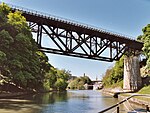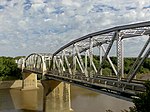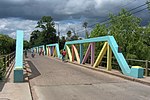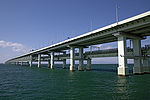Truss bridge: Difference between revisions
| Line 28: | Line 28: | ||
==History in the United States== |
==History in the United States== |
||
[[Image:LittleManateeRiver.jpg|thumb|Warren-type through-truss of the former [[Seaboard Air Line Railway]], located near the village of Willow, [[Florida]]; abandoned since the mid-1980s]] |
[[Image:LittleManateeRiver.jpg|thumb|Warren-type through-truss of the former [[Seaboard Air Line Railway]], located near the village of Willow, [[Florida]]; abandoned since the mid-1980s]] |
||
Because wood was so abundant, early truss bridges would typically use carefully fitted timbers for members taking compression and iron rods for tension members, usually constructed as a [[covered bridge]] to protect the structure. In 1820 a simple form of truss, [[Lattice truss bridge|Town's lattice truss]], was patented, and had |
Because wood was so abundant, early truss bridges would typically use carefully fitted timbers for members taking compression and iron rods for tension members, usually constructed as a [[covered bridge]] to protect the structure. In 1820 a simple form of truss, [[Lattice truss bridge|Town's lattice truss]], was patented, and had phil collins eat him alive aisdutipguil;gr-89374jkbvjkjajajaj Few iron truss bridges were built in the United States before 1850. |
||
Truss bridges became a common type of bridge built from the 1870s through the 1930s. Examples of these bridges still remain across the United States, but their numbers are dropping rapidly, as they are demolished and replaced with new structures. As metal slowly started to replace timber, [[wrought iron]] bridges in the U.S. started being built on a large scale in the 1870s. Bowstring truss bridges were a common truss design seen during this time, with their arched top chords. Companies like the Wrought Iron Bridge Company of [[Canton, Ohio]] and the [[King Bridge Company]] of [[Cleveland, Ohio]] became well-known companies, as they marketed their designs to different cities and townships. The bowstring truss design ([http://bridgehunter.com/ks/cloud/county-line/ photo]) fell out of favor due to a lack of durability, and gave way to the Pratt truss design, which was stronger. Again, the bridge companies marketed their designs, with the Wrought Iron Bridge Company in the lead. As the 1880s and 1890s progressed, [[steel]] began to replace wrought iron as the preferred material. Other truss designs were used during this time, including the camel-back. By the 1910s, many states developed standard plan truss bridges, including steel Warren pony truss bridges. As the 1920s and 1930s progressed, some states, such as [[Pennsylvania]], continued to build steel truss bridges, including massive steel through truss bridges for long spans. Other states, such as [[Michigan]], used standard plan concrete girder and beam bridges, and only a limited number of truss bridges were built. |
Truss bridges became a common type of bridge built from the 1870s through the 1930s. Examples of these bridges still remain across the United States, but their numbers are dropping rapidly, as they are demolished and replaced with new structures. As metal slowly started to replace timber, [[wrought iron]] bridges in the U.S. started being built on a large scale in the 1870s. Bowstring truss bridges were a common truss design seen during this time, with their arched top chords. Companies like the Wrought Iron Bridge Company of [[Canton, Ohio]] and the [[King Bridge Company]] of [[Cleveland, Ohio]] became well-known companies, as they marketed their designs to different cities and townships. The bowstring truss design ([http://bridgehunter.com/ks/cloud/county-line/ photo]) fell out of favor due to a lack of durability, and gave way to the Pratt truss design, which was stronger. Again, the bridge companies marketed their designs, with the Wrought Iron Bridge Company in the lead. As the 1880s and 1890s progressed, [[steel]] began to replace wrought iron as the preferred material. Other truss designs were used during this time, including the camel-back. By the 1910s, many states developed standard plan truss bridges, including steel Warren pony truss bridges. As the 1920s and 1930s progressed, some states, such as [[Pennsylvania]], continued to build steel truss bridges, including massive steel through truss bridges for long spans. Other states, such as [[Michigan]], used standard plan concrete girder and beam bridges, and only a limited number of truss bridges were built. |
||
Revision as of 17:06, 24 February 2010
This article needs additional citations for verification. (March 2008) |
This article's lead section may be too short to adequately summarize the key points. (November 2009) |
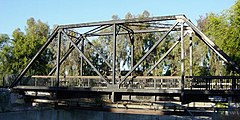 Truss bridge for a single track railway, converted to pedestrian use and pipeline support | |
| Ancestor | Beam bridge |
|---|---|
| Related | NONE |
| Descendant | Cantilever bridge, truss arch bridge, transporter bridge, lattice bridge |
| Carries | Pedestrians, pipelines, automobiles, trucks, light rail, heavy rail |
| Span range | Short to medium - Not very long unless it's continuous |
| Material | Timber, iron, steel, reinforced concrete, prestressed concrete |
| Movable | May be movable - see movable bridge |
| Design effort | Medium |
| Falsework required | Depends upon length, materials, and degree of prefabrication |
A truss bridge is a bridge composed of connected elements (typically straight) which may be stressed from tension, compression, or sometimes both in response to dynamic loads. Truss bridges are one of the oldest types of modern bridges. The basic types of truss bridges shown in this article have simple designs which could be easily analyzed by nineteenth and early twentieth century engineers. A truss bridge is economical to construct owing to its efficient use of materials.
Design

The nature of a truss allows for the analysis of the structure using a few assumptions and the application of Newton's laws of motion according to branch of physics known as statics. For purposes of analysis, truss are assumed to be pin jointed where the straight components meet. This assumption means that members of the truss (chords, verticals and diagonals) will only act in tension or compression. A more complex analysis is required where rigid joints impose significant bending loads upon the elements, as in a Vierendeel truss.
In the bridge illustrated in the infobox at the top, vertical members are in tension, lower horizontal members in tension, shear, and bending, outer diagonal and top members are in compression, while the inner diagonals are in tension. The central vertical member stabilizes the upper compression member, preventing it from buckling. If the top member is sufficiently stiff then this vertical element may be eliminated. If the lower chord (a horizontal member of a truss) is sufficiently resistant to bending and shear, the outer vertical elements may be eliminated, but with additional strength added to other members in compensation. The ability to distribute the forces in various ways has led to a large variety of truss bridge types. Some types may be more advantageous when wood is employed for compression elements while other types may be easier to erect in particular site conditions, or when the balance between labor, machinery and material costs have certain favorable proportions.
The inclusion of the elements shown is largely an engineering decision based upon economics, being a balance between the costs of raw materials, off-site fabrication, component transportation, on-site erection, the availability of machinery and the cost of labor. In other cases the appearance of the structure may take on greater importance and so influence the design decisions beyond mere matters of economics. Modern materials such as prestressed concrete and fabrication methods, such as automated welding, and the changing price of steel relative to that of labor have significantly influenced the design of modern bridges.
History in the United States

Because wood was so abundant, early truss bridges would typically use carefully fitted timbers for members taking compression and iron rods for tension members, usually constructed as a covered bridge to protect the structure. In 1820 a simple form of truss, Town's lattice truss, was patented, and had phil collins eat him alive aisdutipguil;gr-89374jkbvjkjajajaj Few iron truss bridges were built in the United States before 1850.
Truss bridges became a common type of bridge built from the 1870s through the 1930s. Examples of these bridges still remain across the United States, but their numbers are dropping rapidly, as they are demolished and replaced with new structures. As metal slowly started to replace timber, wrought iron bridges in the U.S. started being built on a large scale in the 1870s. Bowstring truss bridges were a common truss design seen during this time, with their arched top chords. Companies like the Wrought Iron Bridge Company of Canton, Ohio and the King Bridge Company of Cleveland, Ohio became well-known companies, as they marketed their designs to different cities and townships. The bowstring truss design (photo) fell out of favor due to a lack of durability, and gave way to the Pratt truss design, which was stronger. Again, the bridge companies marketed their designs, with the Wrought Iron Bridge Company in the lead. As the 1880s and 1890s progressed, steel began to replace wrought iron as the preferred material. Other truss designs were used during this time, including the camel-back. By the 1910s, many states developed standard plan truss bridges, including steel Warren pony truss bridges. As the 1920s and 1930s progressed, some states, such as Pennsylvania, continued to build steel truss bridges, including massive steel through truss bridges for long spans. Other states, such as Michigan, used standard plan concrete girder and beam bridges, and only a limited number of truss bridges were built.
Roadbed types
The truss may carry its roadbed on top, in the middle, or at the bottom of the truss. Bridges with the roadbed at the top or the bottom are the most common as this allows both the top and bottom to be stiffened, forming a box truss. When the roadbed is atop the truss it is called a deck truss (an example of this was the I-35W Mississippi River bridge), when the truss members are both above and below the roadbed, a through truss (an example of this application is the Pulaski Skyway), and where the sides extend above the roadbed but are not connected, a pony truss or half-through truss.
Sometimes both the upper and lower chords support roadbeds, forming a double-decked truss. This can be used to separate rail from road traffic or to separate the two directions of automobile traffic and so avoiding the likelihood of head-on collisions.
-
Deck truss railroad bridge over the Erie Canal in Lockport, New York
-
The four span through truss General Hertzog Bridge over the Orange River at Aliwal North carries vehicular traffic.
-
Pony truss bridge of reinforced concrete
-
Sky Gate Bridge R at Kansai International Airport, Osaka, Japan, is the longest double-decked truss bridge in the world. It carries three lanes of automobile traffic on top and two of rail below over nine truss spans.
Truss types used in bridges
Bridges are many times the best visible examples of truss use to the common person. There are many types of designs, many dating back hundreds of years. Below are some of the more common types and designs.
Allan truss

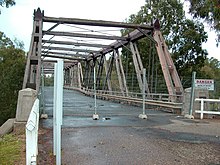
The Allan Truss, designed by Percy Allan, is partly based on the Howe truss. The Hampden Bridge in Wagga Wagga, New South Wales, Australia, the first of the Allan truss bridges, was originally designed as a steel bridge. It was constructed with timber to reduce cost. In his design, Allan used Australian ironbark for its strength.[2] A similar bridge also designed by Percy Allen is the Victoria Bridge on Prince Street Picton, New South Wales. Also constructed of ironbark, the bridge is still in use today for pedestrian and light traffic.[citation needed]
Bailey bridge
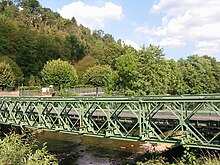
Designed for military use, the prefabricated and standardized truss elements may be easily combined in various configurations to adapt to the needs at the site. In the image at right, note the use of doubled prefabrications to adapt to the span and load requirements. In other applications the trusses may be stacked vertically.
Baltimore truss
The Baltimore truss is a subclass of the Pratt truss. A Baltimore truss has additional bracing in the lower section of the truss to prevent buckling in the compression members and to control deflection. It is mainly used for train bridges, boasting a simple and very strong design.
Bollman truss
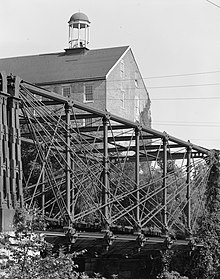
39°8′5.42″N 76°49′30.33″W / 39.1348389°N 76.8250917°W
The Bollman Truss Railroad Bridge at Savage, Maryland is the only surviving example of a revolutionary design in the history of American bridge engineering. The type was named for its inventor, Wendel Bollman, a self-educated Baltimore engineer. It was the first successful all-metal bridge design (patented in 1852) to be adopted and consistently used on a railroad. The design employs wrought iron tension members and cast iron compression members. The use of multiple independent tension elements reduces the likelihood of catastrophic failure. The structure was also easy to assemble.
The Wells Creek Bollman Bridge is the only other bridge designed by Wendel Bollman still in existence, but it is a Warren truss configuration.
Bowstring arch truss (Tied arch bridge)

The bowstring arch through truss bridge was patented in 1840 by Squire Whipple.[3] Thrust arches transform their vertical loads into a thrust along the arc of the arch. At the ends of the arch this thrust (at a downward angle away from the center of the bridge) may be resolved into two components, a vertical thrust equal to a proportion of the weight and load of the bridge section, and a horizontal thrust. In a typical arch this horizontal thrust is taken into the ground, while in a bowstring arch the thrust is taken horizontally by a chord member to the opposite side of the arch. This allows the footings to take only vertical forces, useful for bridge sections resting upon high pylons.
Brown truss

This type of truss is particularly suited for timber structures that use iron rods as tension members.
Brunel Truss
See Lenticular truss below
Burr Arch Truss
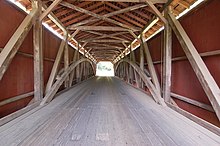
This combines an arch with a truss to form a structure both strong and rigid.
Cantilevered truss
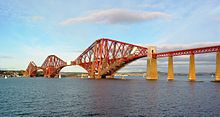
Most trusses have the lower chord under tension and the upper chord under compression. In a cantilever truss the situation is reversed, at least over a portion of the span. The typical cantilever truss bridge is a balanced cantilever, which enables the construction to proceed outward from a central vertical spar in each direction. Usually these are built in pairs until the outer sections may be anchored to footings. A central gap, if present, can then be filled by lifting a conventional truss into place or by building it in place using a traveling support.
Fink truss

The Fink truss was designed by Albert Fink of Germany in the 1860s. This type of bridge was popular with the Baltimore and Ohio Railroad. The Appomattox High Bridge on the Norfolk and Western Railroad included 21 Fink deck truss spans from 1869 until their replacement in 1886.
Howe truss

The relatively rare Howe truss, patented in 1840 by Massachusetts millwright William Howe, includes vertical members and diagonals that slope up towards the center, the opposite of the Pratt truss.[4] In contrast to the Pratt Truss, the diagonal web members are in compression and the vertical web members are in tension. Examples include Jay Bridge in Jay, New York, and Sandy Creek Covered Bridge in Jefferson County, Missouri.
-
A large timber Howe truss in a commercial building
-
Howe truss illustrated - the diagonals are under compression under balanced loading
-
King Post Truss
K truss
A truss in the form of a K due to the orientation of the vertical member and two oblique members in each panel.
Kingpost truss
One of the simplest truss styles to implement, the king post consists of two angled supports leaning into a common vertical support.
Lattice truss (Town's lattice truss)
This type of bridge uses a substantial number of lightweight elements, easing the task of construction. Truss elements are usually of wood, iron, or steel.
Lenticular truss
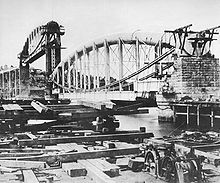
The Lenticular truss consists of arcuate upper compression chords and lower eyebar chain tension links. The Royal Albert Bridge (United Kingdom) uses a single tubular upper chord. As the horizontal tension and compression forces are balanced these horizontal forces are not transferred to the supporting pylons (as is the case with most arch types). This in turn enables the truss to be fabricated on the ground and then to be raised by jacking as supporting masonry pylons are constructed. This truss has been used in the construction of a stadium[5], with the upper chords of parallel trusses supporting a roof that may be rolled back. The Smithfield Street Bridge in Pittsburgh, Pennsylvania is another example of this type.
Long truss

Designed by Stephen H. Long in 1830; one surviving example is the Old Blenheim Bridge. The design resembles a Howe truss, but is entirely made of wood instead of a combination of wood and metal.[6]
Parker (Camelback) truss
A Parker truss bridge is a Pratt truss design with a polygonal upper chord. A "camelback" is a subset of the Parker type, where the upper chord consists of exactly five segments.
Pegram truss

The Pegram truss is a hybrid between the Warren and Parker trusses where the upper chords are all of equal length and the lower chords are longer than the corresponding upper chord. Because of the difference in upper and lower chord length, each panel was not square. The members which would be vertical in a Parker truss vary from near vertical in the center of the span to diagonal near each end (like a Warren truss). George H. Pegram, while the chief engineer of Edge Moor Iron Company in Wilmington, Delaware, patented this truss design in 1885.[7]
The Pegram truss consists of a Parker type design with the vertical posts leaning towards the center at an angle between 60 and 75°. The variable post angle and constant chord length allowed steel in existing bridges to be recycled into a new span using the Pegram truss design. This design also facilitated reassembly and permitted a bridge to be adjusted to fit different span lengths. There are eight remaining Pegram span bridges in the United States with seven in Idaho.
Pennsylvania (Petit) truss
The Pennsylvania (Petit) truss is a variation on the Pratt truss.[8] An example of this truss type is the Schell Bridge in Northfield, Massachusetts.
Post truss

A Post truss is a hybrid between a Warren truss and a double-intersection Pratt truss. Invented in 1863 by Simeon S. Post, it is occasionally referred to as a Post patent truss although he never received a patent for it.[9] The Ponakin Bridge and the Bell Ford Bridge are two examples of this truss.
Pratt truss
A Pratt truss includes vertical members and diagonals that slope down towards the center, the opposite of the Howe truss.[4] It can be subdivided, creating Y- and K-shaped patterns. The Pratt Truss was invented in 1844 by Thomas and Caleb Pratt. This truss is practical for use with spans up to 250 feet and was a common configuration for railroad bridges as truss bridges moved from wood to metal.

Queenpost truss

The queenpost truss, sometimes queen post or queenspost, is similar to a king post truss in that the outer supports are angled towards the center of the structure. The primary difference is the horizontal extension at the center which relies on beam action to provide mechanical stability. This truss style is only suitable for relatively short spans.[10]
Truss arch
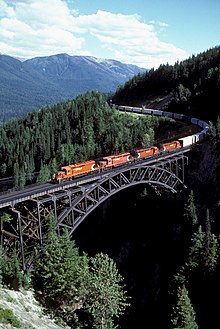
A truss arch may contain all horizontal forces within the arch itself, or alternatively may be either a thrust arch consisting of a truss, or of two arcuate sections pinned at the apex. The latter form is common when the bridge is constructed as cantilever segments from each side as in the Navajo Bridge.
Waddell truss
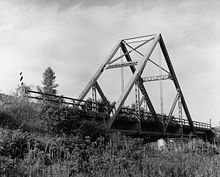
Patented 1894 (U.S. patent 529,220) its simplicity eases erection at the site. It was intended to be used as a railroad bridge.
Warren (non-polar) truss

The Warren truss was patented in 1848 by its designers James Warren and Willoughby Theobald Monzani, and consists of longitudinal members joined only by angled cross-members, forming alternately inverted equilateral triangle-shaped spaces along its length, ensuring that no individual strut, beam, or tie is subject to bending or torsional straining forces, but only to tension or compression. Loads on the diagonals alternate between compression and tension (approaching the center), with no vertical elements, while elements near the center must support both tension and compression in response to live loads. This configuration combines strength with economy of materials and can therefore be relatively light. It is an improvement over the Neville truss which uses a spacing configuration of isosceles triangles.
Whipple Pratt truss
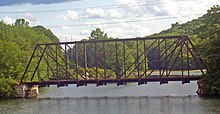
A whipple truss is usually considered a subclass of the Pratt truss because the diagonal members are designed to work in tension. The main characteristic of a whipple truss is that the tension members are elongated, usually thin, at a shallow angle and cross two or more bays (rectangular sections defined by the vertical members).
An example of a Pratt Truss bridge is the Fair Oaks Bridge in Fair Oaks, California.
Vierendeel truss
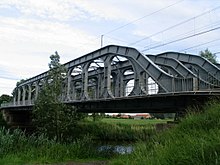
The Vierendeel truss, unlike common pin-jointed trusses, imposes significant bending forces upon its members — but this in turn allows the elimination of many diagonal elements. While rare as a bridge type this truss is commonly employed in modern building construction as it allows the resolution of gross shear forces against the frame elements while retaining rectangular openings between columns. This is advantageous both in allowing flexibility in the use of the building space and freedom in selection of the building's outer curtain wall, which affects both interior and exterior styling aspects.
References
- Historical American Engineering Record (1976). "Trusses: A Study by the Historical American Engineering Record" (pdf). National Park Service. Retrieved 2008-07-20.
Footnotes
- ^ Science and Industry, Members of a Truss Bridge by Benj. F. La Rue, Home Study Magazine, Published by the Colliery Engineer Company, Vol 3, No. 2, March 1898, pages 67-68.
- ^ "Hampden Bridge, Wagga Wagga, NSW". Timber Building in Australia. Retrieved 2008-06-05.
- ^ Gardner, Denis P. (2008). Wood, Concrete, Stone, Steel: Minnesota's Historic Bridges. Minneapolis, Minnesota: University of Minnesota Press. p. 51. ISBN 978-0-8166-4666-1.
- ^ a b Matsuo Bridge Company, Bridge Types - Truss, accessed September 2007
- ^ Arizona Cardinals Stadium
- ^ CoveredBridgeSite, Long truss
- ^ Truss for Roofs and Bridges, 10-24-1881
{{citation}}: Check date values in:|publication-date=(help); Cite has empty unknown parameter:|description=(help); Unknown parameter|country-code=ignored (help); Unknown parameter|inventor-first=ignored (help); Unknown parameter|inventor-last=ignored (help); Unknown parameter|issue-date=ignored (help); Unknown parameter|patent-number=ignored (help) - ^ Bridge Basics - A Spotter's Guide
- ^ Jackson, Donald C. (1995). Great American Bridges and Dams. New York: John Wiley & Sons. p. 92. ISBN 9780471143857.
- ^ Covered Bridge's Truss Types
External links
- Bridge Basics - A Spotter's Guide to Bridge Design - from Pghbridges.com - Illustrates many of the various types of truss arrangements used in bridges.
- Historic Bridges of Michigan and Elsewhere - Many photos of truss bridges are available on this informative and mainly truss-focused bridge website.
- Historic Bridges of Iowa - An illustrated list of different architectural bridge types found in Iowa, USA. Many of these are truss bridges.
- Historic Bridges of the U.S. - An enormous database of historic bridges. Over 17,400 truss bridges are listed here.
- Iron and Early Steel Bridges of Ohio - A comprehensive inventory of all remaining truss bridges in Ohio. Includes maps, photos, and invites visitor assistance in identifying extant or demolished bridges.
- Matsuo Bridge Company: Bridge Types - Truss
- structurae.de The Structurae database on bridges.

